
I like to climb trees.
Wow, that is definitely a Nan Sequitur! I thought this blog is about cello...
I'm just saying, that's probably something you didn't know about me. I like to work out, but mostly by doing things that are fun for me: gardening, home improvement projects, dancing...tree climbing.
Wow, that is definitely a Nan Sequitur! I thought this blog is about cello...
I'm just saying, that's probably something you didn't know about me. I like to work out, but mostly by doing things that are fun for me: gardening, home improvement projects, dancing...tree climbing.
 Back in my San Fran days Back in my San Fran days Because it takes the right tree and the right clothing at the right time, that last activity is a rare treat for me (although this spring, a pruning project in the yard did provide a brief foray up into some branches!). So sometimes, when the urge strikes, I will settle for doing something like a tripod headstand. (I know those two things are not related, but they are related in my mind. They both put my body in a novel situation, using my own strength). |
That's nice, Nan, but what does this have to do with cello?
Hang on, I'm getting there!
Lately, I have wanted to do more than a headstand, so I signed up for Chris Salvato's FREE 28-day HANDstand Challenge.
Are you trying to get us to buy something?
No, I promise I am not advertising for this guy! (Even if I were, the Handstand Challenge materials are free.) I was just looking around on the internet for some fun bodyweight exercises to do and was instantly taken in by Chris's positive attitude and helpful advice on consistent practicing and its role in developing a new and challenging skill...
And of course I had to draw connections to the wonderful world of cello and the difficulties we all face with finding the time and motivation to practice.
Hang on, I'm getting there!
Lately, I have wanted to do more than a headstand, so I signed up for Chris Salvato's FREE 28-day HANDstand Challenge.
Are you trying to get us to buy something?
No, I promise I am not advertising for this guy! (Even if I were, the Handstand Challenge materials are free.) I was just looking around on the internet for some fun bodyweight exercises to do and was instantly taken in by Chris's positive attitude and helpful advice on consistent practicing and its role in developing a new and challenging skill...
And of course I had to draw connections to the wonderful world of cello and the difficulties we all face with finding the time and motivation to practice.
Consistency is key
The limiting factor for handstands, as with cello playing , is consistent practice of the skill.
In other words, what holds us back from making progress with either of these activities is NOT how old we are, how talented we are, or how passionate we are.
It's usually all about not "finding" the time to practice.
Now, we all know that despite how busy our lives can be, there is Always Room 4 Cello! The hardest part is getting the cello out of the case... and then keeping a regular schedule of practice.
In other words, what holds us back from making progress with either of these activities is NOT how old we are, how talented we are, or how passionate we are.
It's usually all about not "finding" the time to practice.
Now, we all know that despite how busy our lives can be, there is Always Room 4 Cello! The hardest part is getting the cello out of the case... and then keeping a regular schedule of practice.
| So, store your cello between sessions in a stand (I like this one, pictured left, because you can keep your endpin out and waste less time getting your cello posture set) so when you find your practice time you can just grab it and go for it!
|
Just A.C.T.
Now for the real challenge: CONSISTENCY! There are three things you can do to help you keep up with your practice, and I have organized them with this mnemonic acronymn to help us all remember:
Anchor.
Chart.
Two-rule.
Anchor.
Chart.
Two-rule.
A is for Anchor

This is something that I already encourage my students to do, but could never express clearly! (Thanks to Chris for clarity on this subject!)
In order to remember to practice, it is helpful to attach your cello time to another required daily event, such as enjoying your morning coffee, arriving home from school or work, getting out of bed in the morning, or going to bed at night.
This is called anchoring.
You can place a reminder near the place where that event occurs to help motivate you.
Soon it will become a habit and you will simply associate that activity with your cello work!
C is for Chart
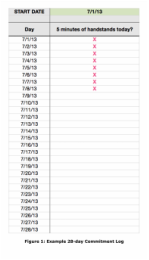 Chris Salvato's "Did you practice?" chart Chris Salvato's "Did you practice?" chart If you study with me, you are probably already familiar with practice charts. We use these for helping us stay organized with our weekly goals for our cello work (see right). But the 28-Day Handstand Challenge requires a simpler "Did you practice?" chart, like the one at left. It's nothing fancy, just put a checkmark on the days you get any practice done. Yes. Even if it is only 5 minutes! It's not about time spent. It's about making handstand practice--and cello practice--a daily part of life! |
T is for Two-rule
Life happens.
There will be days when it is impossible for you to have any time with your cello. When that occurs, you should try 5 minutes of mental practice, which includes activities like marking your music, listening to recordings of the piece you are working on, singing your piece, or going through the bowings, fingerings, or dynamics of that piece in your mind.
That stuff counts! Mark a big check for that day if you get some mental practice done!
But what if I have such a messed up day that I can't manage any mental practice either? What then?
If and when that happens, just mark an O for the day and remember the Two-rule:
Make sure you don't miss two days in a row!
This is so important because it gives you an action to take when this unavoidable problem arises. Instead of wasting time beating yourself up and identifying yourself as a failure, you can think of what you will do tomorrow.
This way one missed day isn't a big deal!
So many times in my life, a glitch in perfection like this has been so demoralizing. At these times, I try to remember:
Perfect is the enemy of good.
There will be days when it is impossible for you to have any time with your cello. When that occurs, you should try 5 minutes of mental practice, which includes activities like marking your music, listening to recordings of the piece you are working on, singing your piece, or going through the bowings, fingerings, or dynamics of that piece in your mind.
That stuff counts! Mark a big check for that day if you get some mental practice done!
But what if I have such a messed up day that I can't manage any mental practice either? What then?
If and when that happens, just mark an O for the day and remember the Two-rule:
Make sure you don't miss two days in a row!
This is so important because it gives you an action to take when this unavoidable problem arises. Instead of wasting time beating yourself up and identifying yourself as a failure, you can think of what you will do tomorrow.
This way one missed day isn't a big deal!
So many times in my life, a glitch in perfection like this has been so demoralizing. At these times, I try to remember:
Perfect is the enemy of good.
...and you will be well on your way to making your cello practice (if not handstands!) a consistent part of your life!
Happy practicing!
Happy practicing!

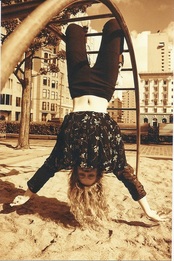


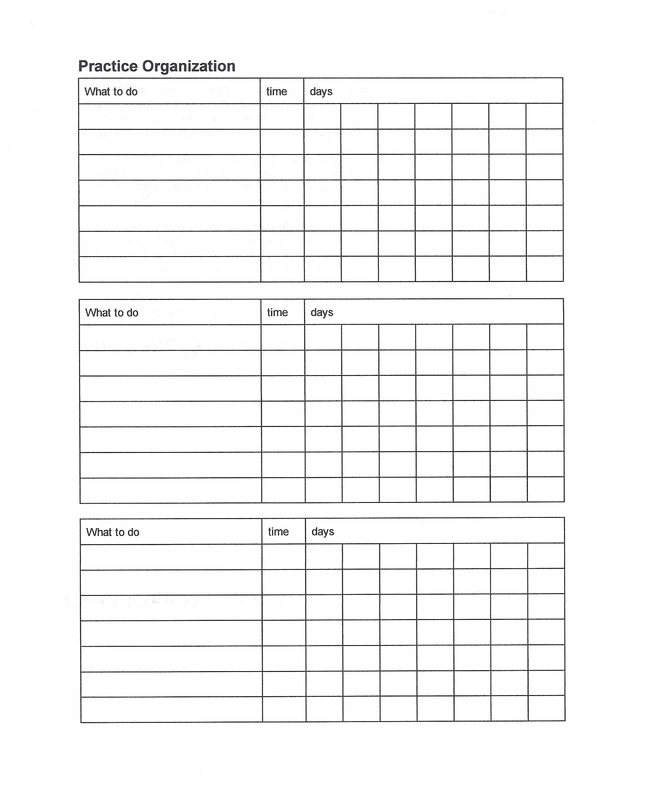
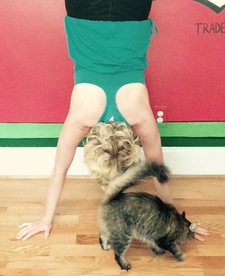
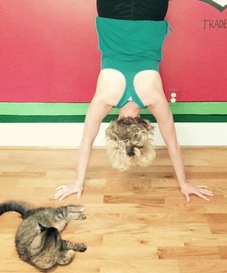
 RSS Feed
RSS Feed